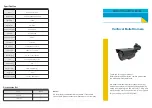
Page
12
C2670M
‐
C
HEATING VENTILATION AND AIR CONDITIONING (HVAC)
The
HVAC
system
should
be
sized
to
meet
the
recommended
requirements
of
the
Endura
system
and
account
for
any
additional
equipment
that
may
also
be
in
the
server
room.
Racks
and
room
layout
need
to
be
configured
to
ensure
that
cold
air
is
available
at
the
front
of
each
unit
and
heated
air
is
exhausted
at
the
back.
Refer
to
Table
C
on
page
11
for
BTU/H
figures
for
each
of
the
Endura
components.
HVAC
VENT
LAYOUT
The
HVAC
strategy
should
be
capable
of
exhausting
every
kilowatt
of
heat
produced
by
the
Endura
equipment
housed
in
the
room.
Generally,
Endura
servers
do
not
discriminate
between
cold
air
intake
and
heated
air
intake;
whatever
is
present
in
front
of
the
unit
will
be
drawn
into
the
unit
and
relied
upon
to
cool
sensitive
electronic
components.
The
layout
of
the
vents
in
relation
to
the
rack
position
is
critical.
The
basic
principal
in
rack
room
design
is
to
minimize
the
impedance
to
airflow
for
cold
air
getting
into
the
equipment
and
heated
air
being
removed
from
the
room.
Thermodynamics
principals
dictate
that
air
will
naturally
move
where
there
is
the
least
resistance;
therefore,
it
is
critical
to
ensure
that
the
rack
room
and
rack
configuration
is
carefully
designed
to
deliver
the
desired
airflow
pattern.
Endura
servers
use
active
cooling
to
pull
cool
air
in
through
the
front
of
the
unit
and
exhaust
heated
air
out
of
the
back
of
the
unit.
The
ideal
server
room
configuration
utilizes
cold
and
hot
aisles.
HVAC
vents,
placed
either
in
the
floor
or
the
ceiling,
blow
into
the
aisle
where
the
front
of
the
equipment
is
located.
Each
server
uses
internal
fans
to
draw
air
in
and
across
sensitive
electronics.
The
heated
air
being
exhausted
by
the
system
is
pumped
into
hot
aisles
where
the
exhaust
system
removes
it,
ensuring
that
it
does
not
recirculate
to
the
front
of
the
rack.
For
this
to
work
properly,
the
installation
should
ensure
that
heated
air
is
not
recirculated
to
the
front
of
the
unit.
An
easy
way
to
do
this
is
to
use
racks
with
solid
side
panels
and
a
fan
‐
assisted
exhaust
system
for
heat
removal.
Depending
on
the
configuration
of
servers
inside
the
rack,
pockets
of
hot
air
might
be
trapped
underneath
deeper
servers.
Make
sure
to
design
racks
so
that
the
shallower
components
are
placed
at
the
top
of
the
rack
and
the
deeper
components
at
the
bottom
of
the
rack.
WARNING:
Incorrect
vent
layout
can
result
in
a
lack
of
air
movement,
which
could
lead
to
equipment
overheating.
Make
sure
that
any
fans
installed
within
the
rack
are
pulling
air
out
of
the
rack,
not
pushing
air
into
the
rack.
Pushing
air
into
the
rack
will
result
in
the
cabinet
becoming
pressurized,
leading
to
a
lack
of
airflow
and
possible
overheating.
Please
refer
to
the
rack
manufacturer’s
recommendations.
Where
possible,
please
use
IT
‐
oriented
rack
layout
schemes
instead
of
A/V
rack
equipment
and
guidelines.




































